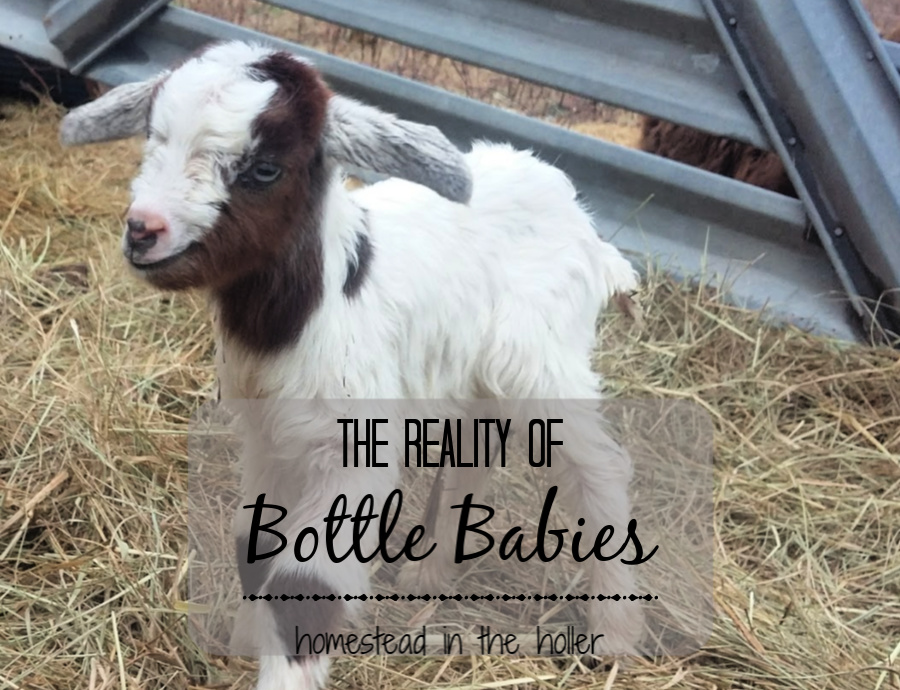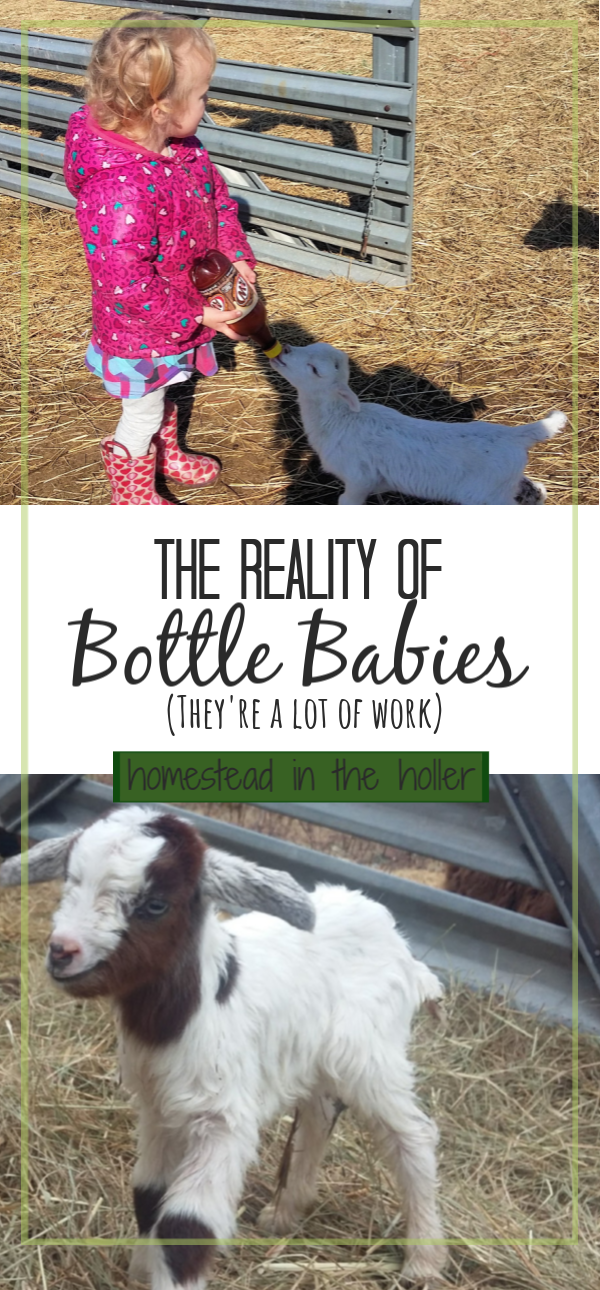Homestead in the Holler is a participant in the Amazon Services LLC Associates Program, an affiliate advertising program designed to provide a means for sites to earn advertising fees by advertising and linking to amazon.com.
It’s the time of year when you start seeing lambs and goat kids for sale as bottle babies on Craigslist at low prices. They are so CUTE!! But before you make a spontaneous buy and come home with a 2 day old lamb, there are some realities to having bottle babies that we need to discuss.
What are you getting?
First, it’s important to know what you are getting, when you decide to purchase a bottle baby. There could be several reasons why this little baby is for sale. It could be a large goat dairy that wants to start milking the goats without the babies getting in the way, the mom could have rejected the baby, the lamb or kid seems weak or it’s simply a boy. The good deal means that they’re trying to get rid of this cute little lamb or goat kid as soon as possible.
Why on earth would someone want to be rid of an adorable little bottle baby??
Extra work
When those lambs and goat kids are with their moms, the moms do all of the work for you. Sure, you’re checking on them to make sure all is well, but you are not responsible for feeding at all hours of the day and night, keeping them warm, and teaching them how to be a sheep or goat. Take the mom out of the equation, and you become the mom. You must purchase milk replacer and feed those bottle babies on a schedule for 2-3 months. When the babies are young, feeding will be round the clock.
As those babies grow you will become acutely aware of a couple things: the cost to feed them and the challenge of keeping them healthy.
Cost
That $50 lamb or goat kid that seemed like a steal, suddenly isn’t when you see how much milk replacer costs and how much they drink in a day. Milk replacer is expensive, $20 for a 4 lb bag which will last about 2 weeks for one lamb or goat. Plan on going through several bags before your bottle baby is ready to be weaned. You can buy special bottles for your bottle babies, but we’ve always used plastic soda bottles and a Pritchard teat bottle nipple.
Don’t forget to count your time. You will spend a lot of time, day and night feeding your bottle babies. It’s best to keep them on a feeding schedule. Your life will revolve around those little animals for a while. Skipping a feeding or not sticking to a schedule can negatively affect their health.
Health
Once you have a bottle baby, you will constantly be asking yourself these questions. Is she getting enough milk? Am I feeding her too much? Does he have the runs? When can I start weaning?!? When you allow nature to work as intended, you never have to ask yourself those questions.
The health of bottle babies starts right off at the very start of their life. If they receive colostrum within the first 24 hours of their life, they will have a much better chance of being a healthy, hardy animal. Colostrum is a highly nutritious energy source that is key to survival. It also contains antibodies that will help protect the lamb or goat kid against disease. If they did not receive colostrum, you’re playing a game of Russian Roulette. Those lambs/goat kids will be more susceptible to diseases and may fail to thrive.
How much these little animals eat will affect their health as well. Feeding too much will result in scours (diarrhea). A small animal can dehydrate quickly, so it is necessary to get scours under control right away. A lamb or goat kid will always act starving, even if they’ve gotten enough milk for that feeding. If you watch a doe and goat kid, the kid will try to get milk even if they aren’t really hungry. Its just what they do.
Safety
This is one reality that a lot of people don’t think of. Bottle babies aren’t going to hurt you as babies. Rams and bucks that have been bottle fed can be very dangerous. Once the fear of humans is lost by being bottle fed, rams and bucks can become very demanding and dangerous if you don’t comply with their whims. A bottle fed ram should be castrated before he hits puberty for your safety.
We have had an adult ram and an adult buck, that were both bottle fed. You could never turn your back on the ram, he would go after you every time. Thankfully he never hurt us badly. But he didn’t last long on our farm either. We have an acquaintance that broke her back from a ram hitting her in the back when she squatted down to fix the fence. Thankfully she recovered from her injury. The bottle fed buck was friendly, but too friendly. He wanted to play with us, head butts and all, like we were goats. Travis had to show him alpha dominance several times before we finally got rid of him. Both animals were too much of a risk to have on our farm. Especially when our kids are out helping with chores.
Exceptions
Of course there are exceptions to every rule. We have cared for bottle babies on our farm numerous times. If a lamb is rejected by it’s mom, or worse, if the mom dies, we sure aren’t going to just let that little baby die. The difference is we will bottle feed our own lambs, but choose not to purchase a lamb or goat kid to bottle feed.
It is fun to raise a lamb or goat kid on a bottle. My kids have loved the experience of raising lambs and goat kids on a bottle. It is a great way to have a tame an animal. If you choose to go ahead and get a bottle baby, great! Just be aware of what you’re getting into and the work involved.
Did you enjoy reading about the realities of farm life? Here’s another article that you may be interested in.

Hi! Around here I wear many hats. Homesteader, farmer, homemaker, homeschool mom, gardener and builder. We strive for a simple, self-sufficient life on our little piece of paradise. Read more





2 responses to “Reality of Bottle Babies”